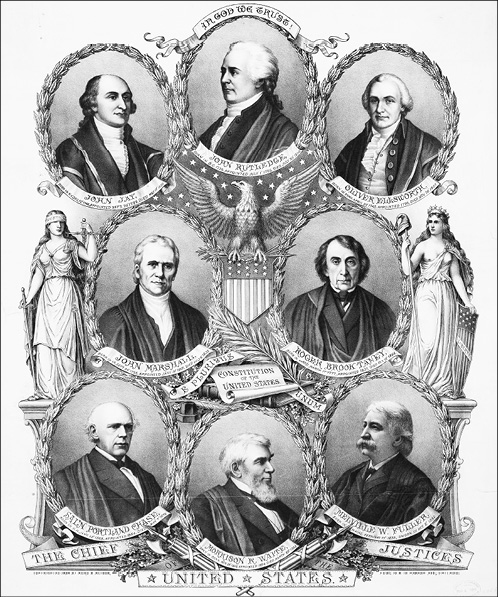16 CHIEF JUSTICE JOHN G. ROBERTS JR. on the U.S. Supreme Court
“I get to do the kind of work I enjoy, in service of the country that I love, with eight wonderful people. And I can do it for as long as I want. That’s a pretty good combination.”
The legal world has produced, in every generation, a few individuals who seem destined to rise to the top of the profession. John G. Roberts Jr. is one of those individuals: an honors graduate of Harvard College (he made it through in three years), an honors graduate of Harvard Law School (where he was the managing editor of the Harvard Law Review), a clerk for Judge Henry J. Friendly of the U.S. Court of Appeals for the Second Circuit, a clerk for Supreme Court Justice William H. Rehnquist, a special assistant to the attorney general of the United States, an associate White House counsel, the principal deputy solicitor general, and one of the finest Supreme Court advocates in recent decades.
But life rarely goes forward without setbacks. John Roberts had one in 1992 when he was nominated to be a judge on the U.S. Court of Appeals for the D.C. Circuit by President George H. W. Bush. The end of the first Bush presidency arrived before the U.S. Senate acted on the nomination, and Roberts remained in private practice for another eleven years.
He might well have stayed there for the rest of his career. A lawyer who wants to be a judge rarely gets a second bite at the apple.
But in 2001, President George W. Bush, recognizing the obvious legal talent of John Roberts, nominated him again to the Court of Appeals for the D.C. Circuit. The Senate confirmed him in 2003. Two years later, with Justice Sandra Day O’Connor’s retirement, Bush nominated Roberts to be her successor.
However, before the Senate could consider the nomination, Chief Justice William Rehnquist passed away, and President Bush then nominated Roberts to be chief justice. He was confirmed in September 2005 by the Senate. With that he became, at the age of fifty, the youngest chief justice in two hundred years.
The new chief was not only young by the standard of his predecessors, he was young compared to me. (I am five years older.) Perhaps it is a sign of aging when you first realize that the high position of chief justice of the Supreme Court is held by someone younger than you.
The chief justice’s main responsibilities obviously revolve around leadership of the Supreme Court and the federal judiciary. But one of his other duties is to serve as the chancellor of the Smithsonian Institution, the government-supported organization, created in 1846, that now operates nineteen museums and nine research centers. I was appointed to the Smithsonian’s board of regents in 2012, and now serve as chair of the board’s executive committee. In that capacity, I have worked with Chief Justice Roberts on Smithsonian matters and have come to know him reasonably well, and to admire him a great deal (because of his accomplishments, legal acumen, intellect, wit, and work ethic).
Although Chief Justice Roberts is not a professional historian, I thought a departure in the Congressional Dialogues series from a historian interviewee would certainly be warranted if he would agree to let me interview him in this setting. To my delight, he did, and the result was a quite interesting look at his career and at the Supreme Court. The chief justice’s self-deprecating humor and wit, perhaps not widely known, are apparent in the interview.
Of all of the interviews held in the Dialogues series, this one probably attracted the greatest number of members of Congress. While they work in buildings only a few hundred yards away from the Supreme Court, most have little regular contact with the justices. This was therefore an opportunity for them not only to meet the chief justice but to hear his views on so many matters relating to the court.
It is not considered appropriate to ask a sitting justice about the reasoning behind a particular decision or the possible outcomes of future cases. So the discussion does not include those kinds of subjects. But it does nonetheless offer interesting, even rare, insights into the court and its current (still quite young) chief justice.
Chief Justice Roberts provided an inside look at how the Supreme Court operates—how cases are selected to be considered, how oral arguments are used, how the cases are voted upon and assigned for opinion-writing, how the opinions are drafted and announced (without leaks—a Washington rarity), and how the collegiality among the justices is generally maintained, despite wide ideological differences in many areas.
The chief justice might never have had the chance to lead the court, he reveals in the interview, but for a chance encounter while he was an undergraduate at Harvard. He expected to be a historian, and was a history major. But during a cab ride in Boston, the driver mentioned that he too had gone to Harvard and majored in history. That prompted John Roberts to expand his academic interests and to pursue a career—the law—less likely to force him to be driving cabs after graduation.

